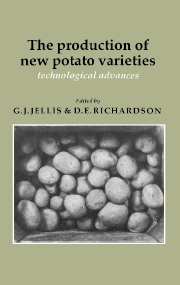Book contents
- Frontmatter
- Contents
- List of contributors
- Preface
- Editors' note and acknowledgements
- Introduction
- The development of potato varieties in Europe
- Genetic Resources
- Breeding Strategies
- Selection and Screening Methods
- The efficiency of early generation selection
- Problems associated with early generation selection of potato clones in West Siberia
- Influence of weight of seed tubers on selection of first year clones: preliminary results
- A joint cyst nematode/late blight test for early generation screening of potato clones
- Screening for resistance to diseases in a potato breeding programme
- Breeding for resistance to potato viruses with special reference to cDNA probes
- Screening for resistance to diseases and pests
- Breeding for resistance to and tolerance of potato cyst nematode
- Breeding multi-resistant potato germplasm
- Resistance to storage diseases in breeding stocks
- Phytophthora research at the Foundation for Agricultural Plant Breeding (SVP)/ The Netherlands
- Effect of time interval between inoculation and assessment on relative content of potato virus YN in leaves of potato plants
- Selection and evaluation of potatoes for improved tolerance of environmental stresses
- Variety Assessment
- Semi-conventional Breeding Methods
- True Potato Seed
- Unconventional Breeding Methods
- Commentary
- Index
Influence of weight of seed tubers on selection of first year clones: preliminary results
Published online by Cambridge University Press: 05 March 2012
- Frontmatter
- Contents
- List of contributors
- Preface
- Editors' note and acknowledgements
- Introduction
- The development of potato varieties in Europe
- Genetic Resources
- Breeding Strategies
- Selection and Screening Methods
- The efficiency of early generation selection
- Problems associated with early generation selection of potato clones in West Siberia
- Influence of weight of seed tubers on selection of first year clones: preliminary results
- A joint cyst nematode/late blight test for early generation screening of potato clones
- Screening for resistance to diseases in a potato breeding programme
- Breeding for resistance to potato viruses with special reference to cDNA probes
- Screening for resistance to diseases and pests
- Breeding for resistance to and tolerance of potato cyst nematode
- Breeding multi-resistant potato germplasm
- Resistance to storage diseases in breeding stocks
- Phytophthora research at the Foundation for Agricultural Plant Breeding (SVP)/ The Netherlands
- Effect of time interval between inoculation and assessment on relative content of potato virus YN in leaves of potato plants
- Selection and evaluation of potatoes for improved tolerance of environmental stresses
- Variety Assessment
- Semi-conventional Breeding Methods
- True Potato Seed
- Unconventional Breeding Methods
- Commentary
- Index
Summary
INTRODUCTION
In the Netherlands most potato breeders grow seedlings in the glasshouse in pots. The heaviest tuber per plant is harvested as seed for the first clonal generation. The seed tubers are small and moreover weight varies enormously within populations. As seed tuber weight affects the phenotype of the first year clones, the variation in weight has a negative effect on selection efficiency. This has been confirmed by the results of Blomquist and Lauer (1962), Swiezynski (1968), Brown et al. (1984) and Maris (pers. comm.). These workers all found that plants obtained from heavier seed tubers had better chances in plant selection but none could specify a weight interval at which tuber weight plays a less decisive role in the selection of first year clones.
Research on this selection problem will be presented in this paper.
MATERIALS AND METHODS
The influence of weight of seed tubers on the phenotype of first year clones is being studied in two similar 2-year experiments. Experiment 1 started in 1984 and ended in 1985 whilst experiment 2 started in 1985 and will be concluded in 1986. During the first experimental year, first year clones were grown in the field. Each genotype was represented by six plants (experiment 1) and eight plants (experiment 2), obtained from tubers differing in weight. For experiment 1 tuber weight ranged between 1.6–80.3 g and for experiment 2 between 1.5–77.5 g.
- Type
- Chapter
- Information
- The Production of New Potato VarietiesTechnological Advances, pp. 78 - 80Publisher: Cambridge University PressPrint publication year: 1987

